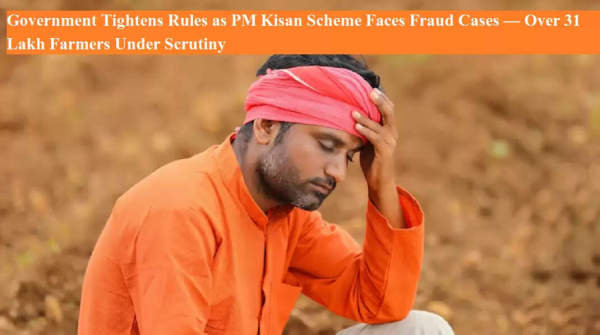
Millions of farmers across India are eagerly awaiting the 21st installment of the Pradhan Mantri Kisan Samman Nidhi (PM-Kisan) scheme. However, even as the government prepares to release the funds, it has launched a massive verification drive to identify beneficiaries who are taking undue advantage of the scheme.
According to the Ministry of Agriculture, more than 31 lakh farmers have been flagged as “suspicious beneficiaries” under the ongoing verification process. These are cases where ineligible individuals — including families claiming double benefits — have received payments in violation of scheme rules.
The government’s latest investigation has uncovered several instances where both husband and wife have been receiving ₹6,000 each annually under the PM-Kisan scheme.
As per official guidelines, only one member of a family — husband, wife, or minor child — is eligible for the benefit. To address this misuse, the Centre had instructed states and union territories to conduct a special verification drive to identify and remove such duplicate beneficiaries.
So far, data shows that of the 31.01 lakh suspicious cases identified, investigations have been completed for about 19.02 lakh cases. Shockingly, around 17.87 lakh, or nearly 94%, were found to be couples claiming the benefit simultaneously.
The government has directed all states to complete the verification process by October 15, ensuring that funds are disbursed only to legitimate farmers in the upcoming installment.
The verification drive has also exposed other forms of irregularities. Around 1.76 lakh minor children have been found registered as beneficiaries, even though the scheme strictly prohibits payments to minors.
Additionally, over 33 lakh records were found with incorrect or outdated ownership details. In some regions, both old and new landowners have been receiving payments for the same plot of land. So far, authorities have identified 8.11 lakh such duplicate cases, and corrective measures are being taken to update ownership data in the PM-Kisan database.
Officials have clarified that the ongoing verification is not intended to delay payments to genuine farmers but to ensure transparency and fairness in the system. By eliminating ineligible beneficiaries, the government aims to channel funds more effectively to deserving farmers who depend on the scheme for livelihood support.
The Ministry of Agriculture has been working closely with state governments to integrate Aadhaar verification, land record digitization, and direct benefit transfer tracking to curb fraudulent claims in the future.
While some states have already begun receiving funds, others may have to wait a little longer. The government has credited the 21st installment of ₹2,000 to farmers in Himachal Pradesh, Jammu & Kashmir, Punjab, and Uttarakhand, regions that were severely affected by floods earlier this year.
However, for farmers in other states, the installment might be delayed until the verification process is completed. If the process takes longer than expected, the release could be pushed to November 2025, though sources suggest the government aims to credit the funds before Diwali if possible.
Launched in 2019, the PM-Kisan Samman Nidhi Yojana provides ₹6,000 per year to small and marginal farmers in three equal installments. The scheme directly transfers funds into beneficiaries’ bank accounts to help them meet agricultural and household expenses.
With over 11 crore registered beneficiaries, it is one of the largest direct benefit transfer (DBT) programs in the world. Ensuring its accuracy and integrity remains a key priority for the government, especially as it prepares to release the next round of payments.
The government’s crackdown on fraudulent claims under PM-Kisan is a step toward ensuring fairness and transparency. While the verification process may cause short-term delays, it will ultimately ensure that only eligible farmers receive the benefits they deserve.
As officials race to complete verification before October 15, millions of genuine farmers hope that their long-awaited installment will arrive just in time for Diwali 2025 — bringing both relief and festive cheer.